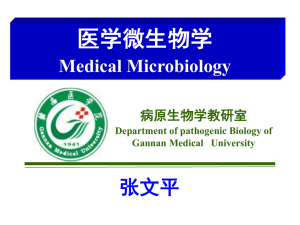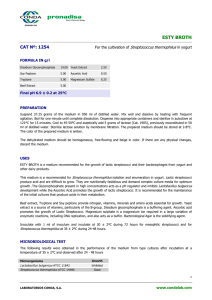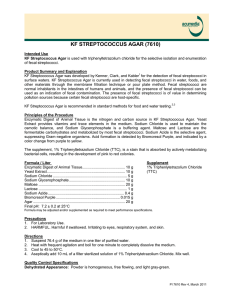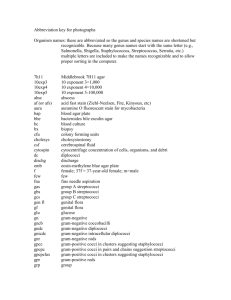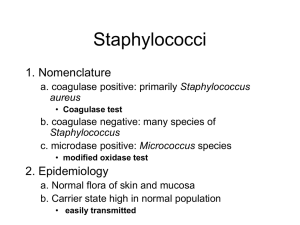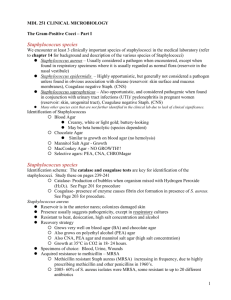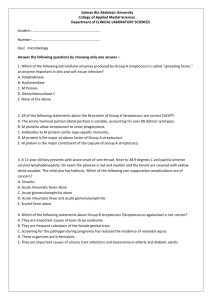microbiology diagnostic of microorganisms related to cardiac
advertisement
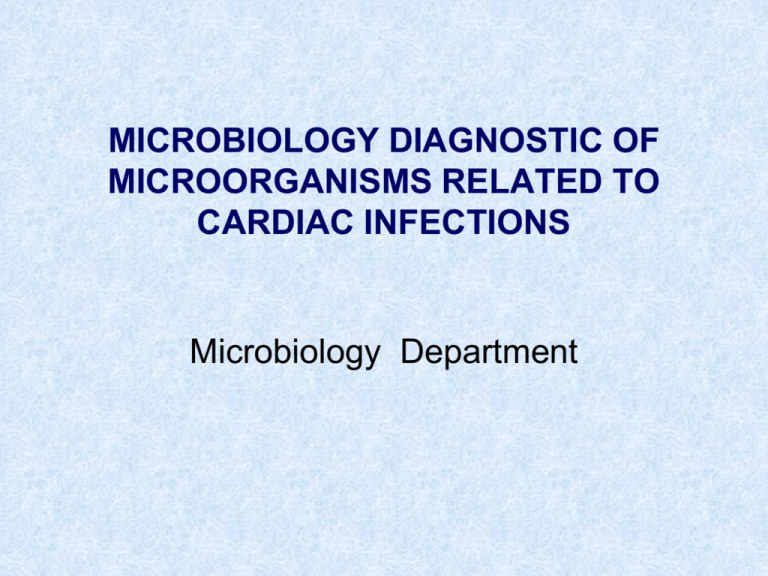
MICROBIOLOGY DIAGNOSTIC OF MICROORGANISMS RELATED TO CARDIAC INFECTIONS Microbiology Department BLOOD CULTURE Purpose To become familiar with : • The microorganisms most frequently associated with bacteremia • Laboratory methods for the isolation and presumptive identification of the etiological agent of bacteremia Collection of specimen : • Blood must be drawn aseptically • At least three blood sample from three different veni-puncture sites, separate from the last at least 1 hour • 10 ml blood should be collected from adult patient PERICARDIAL FLUID Purpose To become familiar with : • Laboratory methods for the isolation and identification of the etiological agent of infective pericarditis Collection of specimens : • Pericardial fluid must be collected aseptically • Should be injected immediately into : – Sterile tube or bottle – Anaerobic transport medium • Sterile heparin may be added to the fluid • Coagulated material should be emulsified Microscopic examination : • Gram stain smear of the centrifuged sediment of clear slightly cloudy fluid should be examined • Purulent material should be smeared directly Culture : The specimens should be streak into medium such as blood agar plate, Mc Conkey, chocolate agar, and Sabouraud agar plate, depend on the result of microscopic examination Blood sample 3-to7-day trypticase soy broth culture, unvented 3-to7-day trypticase soy broth culture, vented Observe for turbidity Observe for turbidity (-) Gram stain Bacilli Brucella medium Brucella sp Cocci Bacilli Blood agar (stab and streak inoculation) Hemolysis Streptococcus sp (for differentiation) Gram stain (-) (+) Diplococci Oviod bodies Cocci MacConkey agar Chocolate agar Sabouraud agar Blood agar and CO2 Enteric bacteria Lactosa fermention (-) (+) LactophenolOxidase test cotton-blue stain Hemolysis (see Exp.36) (see Exp.30) Neisseria sp. Staphylococcus sp (for differentiation) (+) P.Aeruginosa Salmonella sp. Streptococcus sp. (for differentiation) E.coli H2S production (-) (+) P.aeruginosa C.albicans Staphylococcus sp (for differentiation) Salmonella sp. Schema for the isolation and identification of the etiological agents of bacteremia IDENTIFICATION OF HUMAN STAPHYLOCOCCAL PATHOGENS Purpose To become familiar with : • The medical significance of the staphylococci • Selected laboratory procedures designed to differentiate among the mayor staphylococcal species Staphylococcus is : • • • • • Gram-positive cocci Occur as irregular clusters Non-spore-formers Mesophilic bacteria Resistant to drying Staphylococcus The three major species are : • S. aureus • S. saprophyticus avirulent strain • S. epidermidis Infection associated with S. aureus : • Skin infection : boils, carbuncles, acne, impetigo • Internal organ : pneumonia, cystitis, tissue infection osteomyelitis, pyelonephritis, enteritis, septicemia, endocarditis Infection associated with : • S. epidermidis : skin lesions, endocarditis • S. saprophyticus : urinary tract infection S. Aureus metabolic end product : • Coagulase : – Bound coagulase (clumping factor) – Free coagulase • Leukocidin • Haemolysins • Enterotoxin Non-toxic metabolites of S. aureus : – DNase – Lipase – Gelatinase – Staphylokinase Tabel 1. Laboratory test for differentiation of Staphylococcal sp. Test S. aureus S.epidermidis S.saprophyticus MSA : -Growth -Fermentation + + + - + - Coagulase + - - DNase + - - Hemolysis beta - - Novobiocin test S S R Pigmentation Golden yellow white white Coagulase test DNase Test Blood agar Bacteremic Pattern IDENTIFICATION OF HUMAN STREPTOCOCCAL PATHOGENS Purpose To become familiar with : • The medical significance of the streptococci • Selected laboratory procedures designed to differentiate streptococci on the basis of their hemolytic activity and biochemical patterns associated with the Lancefield group classifications Streptococcus is : • • • • Gram-positive cocci in chains Nutritionally fastidious Pinpoint colonies on solid media Requiring enriched media for growth The streptococci are classified base on : • Their haemolytic activity • The serologic classification of Lancefield Haemolytic activity : • Alpha-haemolysis • Beta-haemolysis • Gamma-haemolysis Haemolysis Alpha-haemolysis streptococci : • Incomplete form of haemolysis • Produce a green zone around the colony • Streptococcus viridans are non pathogenic opportunist • May produce sub-acute endocarditis • Streptococcus pneumoniae is the causative agent of pneumonia Beta-haemolysis streptococci : • A complete destruction of red blood cells • Exhibit clear zone around the colony • Producing beta-haemolysins Gamma-haemolytic Gamma-haemolytic streptococci : • Absence of any haemolysis • Most commonly avirulent Lancefield group classification : • Classified streptococci into 20 serogroups • Designated A through V (emitting I and J) • Base on the presence of C-substance, an antigenic group-specific hapten • Implicates the members of group A, B, C and D in human infectious processes Group A : • Beta-haemolytic streptococci in this group referred to as streptococcus pyogenes • Main etiological agents of tonsillitis, bronchopneumonia, scarlet fever, erysipelas and cellulitis • Responsible for glomerulonephritis and rheumatic fever Group B : • Beta-haemolytic streptococci indigenous to the vaginal mucosa • Responsible for puerperal fever, neonatal meningitis and endocarditis Group C : • Beta-haemolytic streptococci • Have been implicated in erysipelas, puerperal fever, and throat infections Group D : • Exhibit alpha or gamma-haemolysis • Includes enterococci such as Enterococcus faecalis • An etiological agent of urinary tract infections • The non-enterococci such as S. bovis Extra-cellular metabolites of streptococci : • • • • • • Haemolysin (alpha and beta) Leukocidins Erythrogenic toxin Hyaluronidase (spreading factor) Streptokinase (a fibrinolysin) Nucleases (ribonuclease and deoxybonuclease) Tabel 2. Laboratory Differentiation of Streptococci Group Organisms A S.ptogenes B S.agalactiae C S. equi D Enterococci E.faecalis Nonenterococci S.Bovis Hemolysis beta beta beta Alphagamma Alphagamma Bacitracin test + - - - - CAMP test - + - - - Bile esculin hydrolysis - - - + + 6.5% NaCl medium - - - Growth - Growth at 10o C - - - Growth - Growth at 45oC - - - Growth Growth or -
